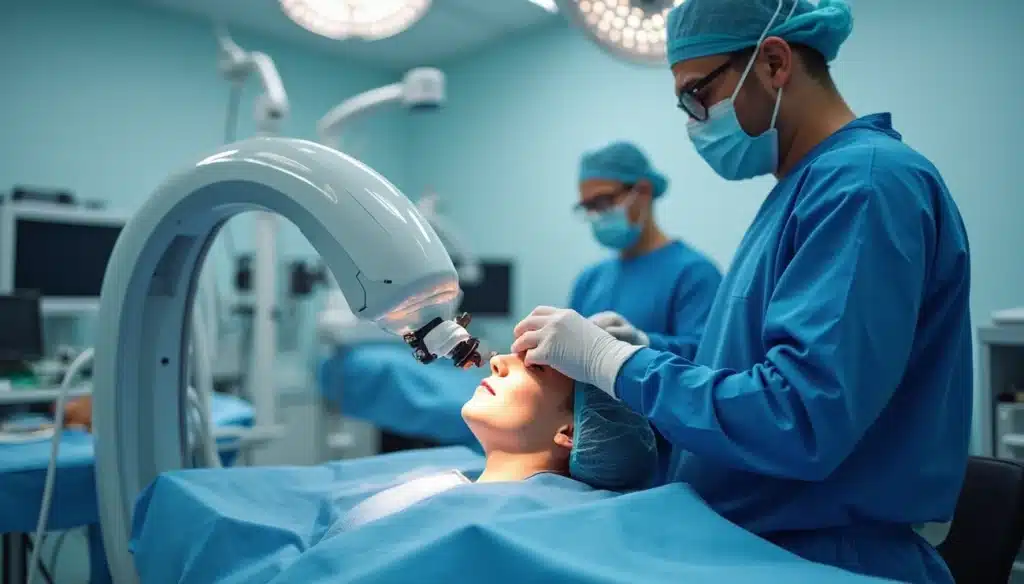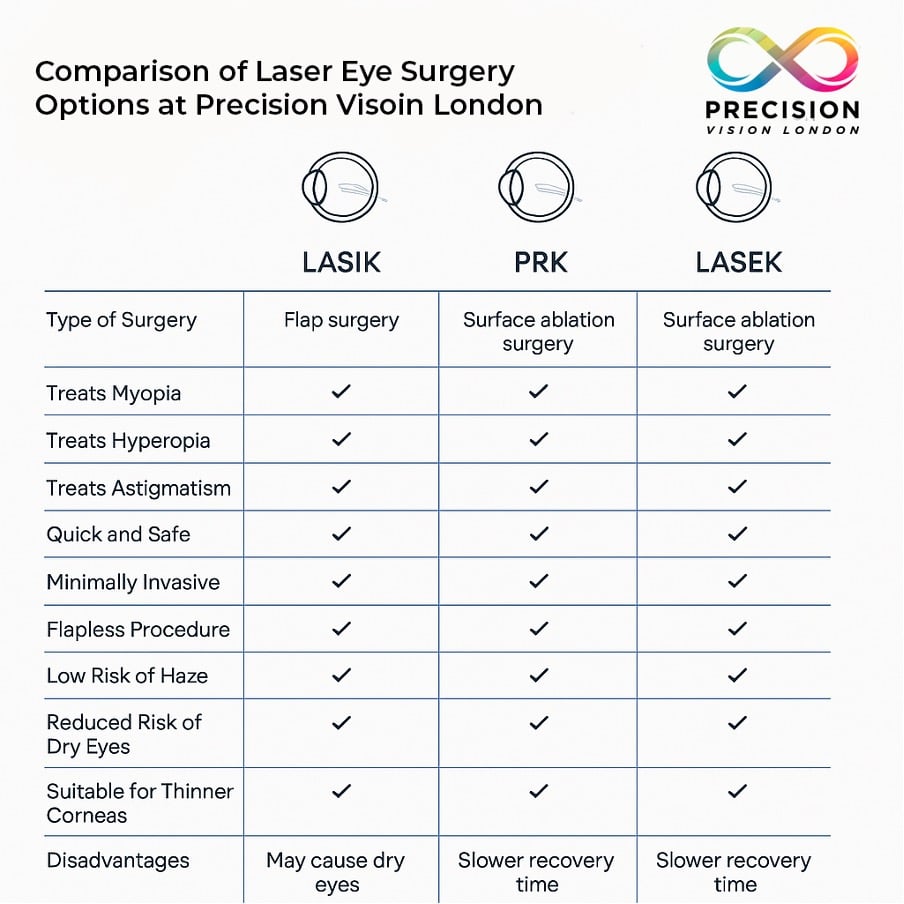Corrective eye surgery proves safer than most people imagine. Research from the UK analysed 67,893 eyes and found the risk of losing two or more lines of vision affects just 1% or less of treated eyes. These numbers are nowhere near the 5% standard that regulatory authorities set.
You might ask if laser eye surgery will be safe for your vision needs. The data looks promising. Results show 99.75% of patients who went through laser refractive surgery met driving standards afterward. Nearly 98.8% said they were happy with their results. Expert surgeons report only 1 in 30,000 patients experience permanently reduced vision that cannot be corrected.
Today’s options for corrective eye surgery include LASIK, PRK, and SMILE. Each has its own safety profile that you should think over before deciding. LASIK helps patients recover quickly, while SMILE disrupts the cornea less. Laser eye surgery risks remain rare – severe complications or sight loss from infection happen to about 1 in 10,000 cases.
This piece explains everything in these procedures – from what makes them safe to how UK clinics measure safety. Modern technology and skilled surgeons create an exceptional safety record for corrective eye surgery in the UK today.

Understanding the Safety of Corrective Eye Surgery
Medical experts assess corrective eye surgery’s safety through strict standards and complete metrics that lead to the best patient outcomes. Understanding these safety measures helps you make better decisions about your eye health.
What makes a procedure ‘safe’?
Several significant factors determine safety in corrective eye surgery. We focused on procedures that maintain or improve vision without causing permanent damage. The risk of serious complications remains low, with less than 1 in 5000 patients needing a corneal transplant to restore vision after laser surgery. Patients can usually regain good vision in these rare cases, though they might need glasses or contact lenses afterward.
Medical professionals call a procedure safe if its benefits clearly outweigh the risks. Contact lens use comes with its own set of risks – about 1 in 3000 wearers develop a serious corneal infection each year. A safe procedure should deliver predictable results with minimal side effects that clear up within the expected time.
How safety is measured in UK clinics
UK clinics use several indicators to measure safety:
- Posterior Capsule Rupture (PCR) rate – A critical quality indicator showing how often the capsular bag holding the lens breaks during surgery
- Visual acuity outcomes – Measuring how many patients achieve driving standard vision or better
- Complication rates – Tracking both minor and serious adverse events
Regulatory bodies like the Care Quality Commission (CQC) monitor these metrics closely. Many UK clinics take part in the Royal College of Ophthalmologists’ National Ophthalmology Database Audit that helps measure against national standards. This system makes shared safety records possible and helps maintain high standards.
UK statistics on visual outcomes and satisfaction
British patients report excellent results after corrective eye surgery. Research shows that 97% of short-sighted patients see 20/20 or better after surgery. Complete reviews show safety rates of 99.6%, and over 90% of patients achieve 20/20 vision without glasses or contacts. Patient satisfaction stays remarkably high—between 95-97% of patients say they’re happy with their results. Long-term studies show satisfaction rates around 91%, and 94.7% of patients would choose the same procedure again. Vision loss risks remain minimal. The chance of losing two lines of best-corrected vision is about 1 in 1,000. Most side effects like dry eyes, glare, or halos usually clear up within a few months after surgery.
Types of Corrective Eye Surgery and Their Safety Profiles
Modern corrective eye surgery comes with several procedure types. Each type has a different safety profile. This knowledge helps you pick the best treatment for your vision needs.

LASIK: Is LASIK eye surgery safe?
LASIK stands as one of the safest elective surgical procedures today. The technique uses a femtosecond laser to create a thin protective flap in the cornea. An excimer laser then reshapes the tissue underneath. Both eyes take just 15 minutes to complete. Research shows that major complications rarely occur. Less than 1% of LASIK patients lose more than two lines of vision after surgery. The procedure has become the UK’s leading technique for vision correction since 1995. Most patients see better within 24 hours. About 80% of patients with mild to moderate prescriptions end up with perfect vision.
PRK and LASEK: Surface-based alternatives
PRK and LASEK modify the corneal stroma without creating a flap. These treatments work best for patients with thinner corneas or specific medical conditions. PRK removes the corneal epithelium completely. LASEK keeps a thin epithelial layer that goes back after treatment. Both procedures match LASIK’s visual outcomes. Between 68-75% of eyes get within 0.5D of intended correction. The healing takes longer than LASIK. The epithelium needs about a week to heal. These procedures leave less corneal haze than older methods.
SMILE: A minimally invasive option
SMILE shows the newest advance in laser eye surgery. This flapless procedure creates a thin lenticule inside the cornea with a femtosecond laser. A surgeon then takes it out through a small cut. Over 3.5 million procedures have been done worldwide. More than 2,000 surgeons across 70 countries have made SMILE 3 years old. The minimally invasive approach keeps the cornea’s biomechanics intact. This reduces the risk of problems like ectasia.
Refractive Lens Exchange: For age-related vision issues
RLE works best for patients 50 or older who have age-related vision issues. The procedure replaces your natural lens with a synthetic intraocular lens (IOL). RLE boasts a 95% success rate. Most patients can drive without glasses afterward. The surgery takes 30-60 minutes. Recovery lasts 3-4 days. After healing, patients notice better focus, less glare, and clearer colour differences.
Risks and Complications You Should Know
Making an informed decision about corrective eye surgery requires a good understanding of possible complications, even though these procedures have proven very safe. Serious problems rarely occur, but knowing the risks helps you set realistic expectations.
Short-term side effects: Dry eyes, glare, halos
Patients usually experience temporary side effects after corrective eye surgery. Dry eyes affect approximately 30% of LASIK patients. These symptoms peak around three months after surgery and usually clear up within 6-12 months. The procedure disrupts the eye’s natural tear production for a while. Night vision changes like glare, halos, and starbursts around lights become most noticeable after dark. These symptoms get better within the first few months as the corneal swelling goes down. Blurred vision or red spots on the eye’s white part might also appear, but these typically go away within weeks.
Rare but serious risks: Infection, ectasia, flap issues
Infection happens in about 1 in 5,000 cases (0.02%), which is nowhere near as common as infections from contact lens wear (1 in 3,000 yearly). Antibiotics usually clear up these infections effectively. Corneal ectasia makes the cornea bulge from structural weakness and affects less than 0.2% of cases. This rare complication might need rigid contact lenses or, in very rare cases, a corneal transplant. LASIK-specific flap complications show up in about 0.1-1.0% of procedures. These problems involve flap creation, positioning, or healing issues.
How often do complications occur in the UK?
UK laser eye surgery has a remarkably low overall complication rate of about 0.1%. Surgeons can fix most of these rare complications. Only about 1 in 1,000 cases need additional treatment. Vision loss from laser eye surgery happens so rarely—less than one in five million cases—that it ranks among the safest elective procedures available.
Enhancement procedures and long-term stability
About 1-5% of patients might need an enhancement procedure to fine-tune their original results. Doctors perform these touch-ups at least three months after the first surgery when healing completes. Natural ageing causes long-term vision changes rather than procedure failure. Research shows roughly 1% of patients each year might see vision changes that need a second look.
How Precision Vision London Ensures Your Safety
Safety lies at the heart of Precision Vision London’s approach to corrective eye surgery.
Advanced diagnostic and laser technology
Our clinic uses state-of-the-art equipment with upgrades every three years. This dedication to excellence gives greater accuracy and better results. Our advanced lasers provide precise treatments in less time. The diagnostic tools create detailed maps of your eye’s unique features.
Thorough pre-operative screening
Need corrective eye surgery but worried about safety? Precision Vision London puts your safety first with world-class surgeons and advanced laser technology. Book your consultation now to get expert guidance and a risk-free evaluation.
Our pre-operative assessments give you a full picture through:
- Complete refractive evaluations
- Detailed corneal mapping and tomography
- Assessment of tear production and dry eye risk
- Pupil size measurement in various light conditions
These evaluations spot even subtle conditions that could affect your treatment’s success.
Experienced UK-qualified surgeons
Our consultant surgeons rank among the best in their field, bringing exceptional expertise to your procedure. Each surgeon dedicates their practise to corrective eye surgery, offering specialised care that leads to optimal outcomes. You’ll have direct access to your consultant throughout your recovery.
Personalised treatment planning
Each patient’s visual needs differ, so we create fully customised treatment plans. Your plan takes into account your prescription and lifestyle factors that shape your visual needs. This custom approach helps us meet your specific vision goals with precision.
Complete aftercare and follow-up
Your care after surgery plays a vital role in success. The aftercare package comes with medication instructions, protective measures, and scheduled follow-ups. Our team checks your progress the day after surgery and throughout recovery. You’ll have support whenever questions come up.
Conclusion
Corrective eye surgery is one of the safest elective procedures today. UK research shows exceptional safety records for all treatment options. Each procedure has its own benefits and boasts impressive success rates. More than 95% of patients achieve driving standard vision or better. Of course, temporary side effects like dry eyes can occur, but serious complications are rare—less than one in five million cases lead to vision loss.
Your surgical outcome and safety depend heavily on choosing the right clinic. Precision Vision London sets the gold standard with its outstanding CQC rating and patient care approach. Thinking about corrective eye surgery but concerned about safety? At Precision Vision London, we prioritise patient safety with world-class surgeons and advanced laser technology. Book your consultation now for expert guidance and a risk-free evaluation. This excellence shows in everything from your first consultation to your final follow-up appointment.
Our detailed pre-operative screening helps you get the most suitable treatment for your vision needs. Modern diagnostic and laser equipment delivers precision that doctors couldn’t achieve ten years ago. The expertise of UK-qualified surgeons who focus only on refractive procedures gives patients exceptional care.
Surgery always carries some risk, but corrective eye surgery has become remarkably safe for vision correction. Data from UK clinics proves both its safety and high patient satisfaction rates. Your vision deserves the highest standards of care—standards that define our practise at Precision Vision London. We make safety our top priority as you start your path to clearer vision.
Key Takeaways
Corrective eye surgery has evolved into one of the safest elective procedures available, with UK research showing exceptional outcomes and minimal risks when performed by qualified specialists.
- UK research shows only 1% of patients lose two or more lines of vision, with 99.75% meeting driving standards post-surgery
- Serious complications are extraordinarily rare—less than 1 in 5,000 require corneal transplant, infection occurs in just 1 in 5,000 cases
- LASIK, PRK, LASEK, and SMILE each offer distinct safety profiles, with recovery times ranging from 24 hours to one week
- Temporary side effects like dry eyes (30% of patients) and light sensitivity typically resolve within 6-12 months
- Thorough pre-operative screening and advanced laser technology are crucial for optimal safety and personalised treatment outcomes
The evidence overwhelmingly supports corrective eye surgery as a safe, effective solution for vision correction, particularly when performed at accredited clinics with experienced surgeons and comprehensive aftercare protocols.
FAQs
Q1. What is considered the safest type of corrective eye surgery? While all modern corrective eye surgeries are generally safe, SMILE (Small Incision Lenticule Extraction) is often regarded as one of the safest options. It’s a minimally invasive procedure that preserves corneal biomechanics and has shown excellent safety outcomes in over 3.5 million procedures worldwide.
Q2. How common are serious complications from laser eye surgery? Serious complications from laser eye surgery are extremely rare. The risk of significant vision loss is less than one in five million cases. Infection occurs in approximately 1 in 5,000 cases, which is actually lower than the annual infection risk from contact lens wear.
Q3. What percentage of patients achieve good vision after corrective eye surgery in the UK? UK studies show that up to 99.75% of patients meet driving standard vision or better after laser eye surgery. Additionally, 97% of short-sighted patients achieve 20/20 vision or better following the procedure.
Q4. How long do the side effects of corrective eye surgery typically last? Most side effects, such as dry eyes and light sensitivity, are temporary. Dry eyes typically peak around three months post-surgery and resolve within 6-12 months. Light-related visual disturbances usually improve within the first few months as corneal swelling subsides.
Q5. What should I look for when choosing a clinic for corrective eye surgery? When selecting a clinic, look for those with experienced UK-qualified surgeons, advanced diagnostic and laser technology, thorough pre-operative screening processes, and comprehensive aftercare programmes. Also, check for clinics with high CQC ratings and transparent safety records.
Authors & Reviewer
-
 Olivia: Author
Olivia: AuthorHi, I'm Olivia, a passionate writer specialising in eye care, vision health, and the latest advancements in optometry. I strive to craft informative and engaging articles that help readers make informed decisions about their eye health. With a keen eye for detail and a commitment to delivering accurate, research-backed content, I aim to educate and inspire through every piece I write.
-
 Dr. CT Pillai: Author
Dr. CT Pillai: AuthorDr. CT Pillai is a globally recognised ophthalmologist with over 30 years of experience, specialising in refractive surgery and general ophthalmology. Renowned for performing over 50,000 successful laser procedures.

